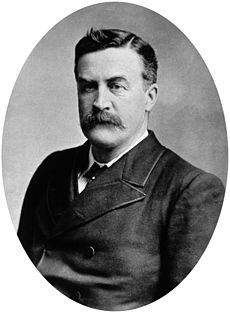Sir Alexander Ogston
| Alexander Ogston | |
|---|---|
 |
|
| Born | 19 April 1844 Aberdeen, Scotland, United Kingdom |
| Died | 1 February 1929 Aberdeen, Scotland, United Kingdom |
| Residence | Aberdeen |
| Alma mater | University of Aberdeen |
| Known for | The discovery of Staphylococcus aureus |
| Spouse(s) | Mary Jane Hargrave (1867–1873) Isabella Margaret Matthews |
| Awards | Fellow of the Royal Society |
| Scientific career | |
| Fields | Surgery/Bacteriology |
| Institutions | Aberdeen Royal Infirmary |
Sir Alexander Ogston KCVO FRS CM MD (19 April 1844 – 1 February 1929) was a British surgeon, famous for his discovery of Staphylococcus. He was the eldest son of Prof. Francis Ogston (1803–1887), Professor of Medical Jurisprudence at the University of Aberdeen.
Ogston began his medical training at Marischal College in 1862 and graduated in 1865 with honours in medicine and surgery at the age of 21. He obtained his MD a year later in 1866. He was appointed as a full surgeon to the Aberdeen Royal Infirmary in 1874. He was Assistant Professor of Medical Jurisprudence and Materia Medica, Lecturer in Ophthalmology and Anaesthetist before being appointed as Regius Professor of Surgery in 1882. He is credited with the introduction of carbolic spray to Aberdeen.
Ogston was reported to have called on Joseph Lister and rigorously followed his antiseptic principals. These are aptly phrased in a small ditty composed by his students.
The spray, the spray, the antiseptic spray
A.O. would shower it morning, night and day
For every sort of scratch
Where others would attach
A sticking plaster patch
He gave the spray.
Ogston followed the work of other contemporaries such as Koch, J.C. Ewart from Edinburgh (published on different types of bacteria), and Kohler from Berne (who found bacteria in cases of osteomyelitis and 'strumitis'.
Following his examination of the organisms from the abscess of James Davidson, Ogston used the shed behind his house as a laboratory (receiving a grant (£50) from the British Medical Association (BMA), with which he purchased a Zeiss microscope and the methyl-aniline dye used by Koch) to continue his research.
Following Kochs postulates and staining methods, Ogston set about isolating the causative organism of Davidson's wound. By experiment Ogston concluded that the optimal conditions for cultivation of this organism were hen's egg medium grown in small bottles shielded from contamination by glass 'shades. Using samples from 82 abscesses, Ogston successfully isolated bacteria from 65 samples, the others being referred to as "cold". He was then able to transfer pure colonies to guinea-pigs, white mice or wild mice. Ogston soon realised there were '"two forms of micrococcus: one in the form of chains or necklaces to which the name ‘streptococcus’ had been given and produced the more violent inflammation, and the other growing in masses or clusters [like the roe of a fish], to which I gave the name 'staphylococcus' which cause a less violent inflammatory disease'. He also noted that a transferring a 1/146 016 000 dilution of the original pus sample could induce abscesses in new subjects. Ogston demonstrated that these bacteria could be killed by heat or carbolic acid, fulfilling Kochs postulates. He also noted that " micrococci so deleterious when injected" were seemingly "harmless on the surface of wounds and ulcers". An observation of the existence of some staphylococci as part of the normal flora.
...
Wikipedia
